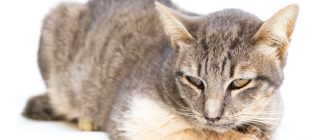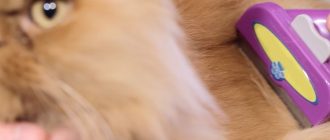Urolithiasis in cats (also called urolithiasis) – a disease caused by the formation of sand and stones (uroliths) in the kidney, bladder, ureter, or urethra animal. Urolites from uric acid, struvites usually consist (phosphates), cystine, oxalates, carbonates. The size of the stones can reach a diameter of up to 2 cm, causing the cat unbearable pain during time to try to urinate. In the most difficult cases, uroliths are capable of completely block the urinary tract. And if not provide the animal with urgent medical care, death inevitable. Diseases are more often affected by individuals over the age of 2 years, and the most vulnerable group are castrated cats. The fact is that the urethra males curved and narrower, which contributes to the formation of sand and stones, complicates their withdrawal with urine. In addition, urolithias the disease often threatens long-haired cats (especially susceptible to it Persian breed). With timely treatment urolithiasis can be successfully cured, however, for the health of the affected animal will have to be monitored throughout life, carefully selecting feed, periodically turning to vet clinic for preventive examinations.
Causes of urolithiasis
Contents
Sand and stones in the kidneys and urinary tract in cats form when metabolic disorders. Many can provoke the disease. factors:
- Improper nutrition (cheap feed, excess protein, low the content of vitamins B6 in products (its deficiency leads to the formation of sand and stones) and A (he is responsible for the normalization of cells epithelium of internal organs), an excess of phosphorus and magnesium);
- Overeating and obesity;
- The cat’s drinking water with a high content of calcium;
- A small amount of drinking water;
- Viral and bacterial urinary infections systems;
- Diseases of the gastrointestinal tract (which can lead to an excess of calcium in the body);
- Inappropriate use of certain medicinal products. drugs;
- Hereditary predisposition;
- Low motor activity (especially in castrated animals).
Symptoms of urolithiasis
Unfortunately, in the early stages of the development of the disease, the owner’s eye does not disturbing symptoms of urolithiasis in a cat are visible. Yes and the animal itself at first may not feel painful reactions until it is about sand or stones of very small size. but an increase in the number and size of uroliths can lead to a sharp pain at every desire of the cat to go to the toilet. Then it can be noted such symptoms:
- The cat rarely goes to the tray (normally the animal should cope small need at least 1-2 times a day);
- On the contrary, frequent urination with very small portions of urine (including outside the tray);
- Urine discoloration (pink tint);
- Urine with blood;
- Anxious pet urination behavior: cat meowingly, often, but to no avail visits the toilet, sits, arching his back in the tray, the genitals licks every now and then;
- Sealing in the area of the bladder during palpation (normal the cat’s stomach should be soft);
- Refusal to take water and food;
- Apathy;
- Temperature increase.
If the disease has gone too far, the unfortunate cat may observed:
- Vomiting
- The absence of urine or its may be negligible (anuria);
- Seizures are possible;
- The development of renal failure;
- Urinary tract obstruction;
- Autointoxication (uremia).
Diagnosis of urolithiasis
The owner of the cat, even noticing such symptoms, should not independently to diagnose an animal. Many of the listed symptoms ills may not necessarily indicate the presence of precisely urolithiasis in a cat. For example, in oncology (in including genitourinary tumors) are often observed and compaction in abdominal cavity, and anxious behavior, and the presence of bloody discharge With cystitis, cats can also behave anxiously, visiting the tray, blood may be present in the urine, jumps are possible body temperature. Thus, diagnosis is a matter of veterinarian. Veterinarian determines the presence of urolithiasis in cats based on the owner’s story about the condition of the pet (it is advisable to inform the doctor about the frequency of urination, the color of urine, the behavior of the animal in the tray). A specialist examines an animal prescribes the passage of ultrasound (kidney and bladder) and radiographs, as a result of the study, the condition will be visible internal organs, the presence and size of stones. In an animal be sure to take urine for a general analysis for the laboratory research.
Treatment of urolithiasis in a cat
Since stones may differ in composition, the correct treatment for urolithiasis in a cat may be Appointed only by a veterinarian. Typically, stones (or sand) can withdraw from the urethra of the cat through a catheter using antibacterial solutions. In more complex cases (when the lumen of the urethra is almost completely blocked by uroliths) may be required urethrostomy is a surgical intervention, the purpose of which is the formation of a new urethral opening for urine excretion. When the diameter of the stones exceeds the diameter of the urethra itself, and the count goes to the clock, cat requires complete removal of stones by surgical method (cystotomy). Such manipulations are carried out by the animal under general anesthesia. Stones after removal are sent to chemical analysis to determine the nature of their appearance (more often total urolithiasis is due to the appearance of oxalates or struvites) – this will help you choose the right treatment. Further to the animal intravenous infusions are required to restore the body after intoxication. Antibiotics, antispasmodics are used, painkillers, anti-inflammatory and antibacterial drugs. In cases where urolithiasis is on initial stage (the cat is able to go small in the urine no impurities in the form of blood, the animal does not feel strong discomfort), doctors may suggest conservative treatment urolithiasis. His goal is to dissolve stones with special diets and the use of diuretic phytopreparations. but the conservative method will bear fruit only after a while, therefore nevertheless most often they treat urolithiasis surgically.
Urolithiasis Prevention
After successful treatment, this disease may never again disturb the cat, provided the owner rules. Clear recommendations for prevention urolithiasis is given by a doctor based on age, condition animal health. Usually, cats undergoing urolithiasis as prevent the development of the disease again:
- Eat quality ready-made medicinal feed (for treatment and prevention of urolithiasis);
- Use only cleaned – filtered or settled water, and also to control that the cat drank enough (not less 150-200 ml of water per day);
- Avoid foods like fish seafood, foods rich in calcium (milk, cottage cheese, cheese, yogurt), salt. Depending on the composition of the stones, cats often banned vegetables, offal, fatty, raw meat;
- Natural nutrition after the drug treatment of urolithiasis should consist of liquid cereals (rice, oat, buckwheat), low-fat boiled meat (rabbit, veal, lamb, chicken, turkey), boiled vegetables (carrots, cauliflower);
- To normalize the work of the kidneys, cleanse the urinary ways and urine excretion is recommended to give cats a diuretic fees (diuretics);
- To support the body, a doctor prescribes vitamin complexes;
- To prevent obesity, the owner should monitor animal activity, try not to overfeed the cat;
- Some time after recovery, it is advisable to show Pet vet, do an ultrasound and X-ray, take a urine test.
Urolithiasis can lead to the development of many severe concomitant diseases that violate not only the work of the kidneys and urinary system, but also the whole body as a whole. Due to the appearance of urolith stones with urine, toxins cannot be excreted, protein substances, salts, the cat’s body poisons itself. Besides In addition, the purr is in severe pain, the quality of her life significantly worse. Therefore, the owner immediately it is necessary to contact the veterinarian, especially in cases where the pet cannot empty the bladder for more than 1-2 days.






